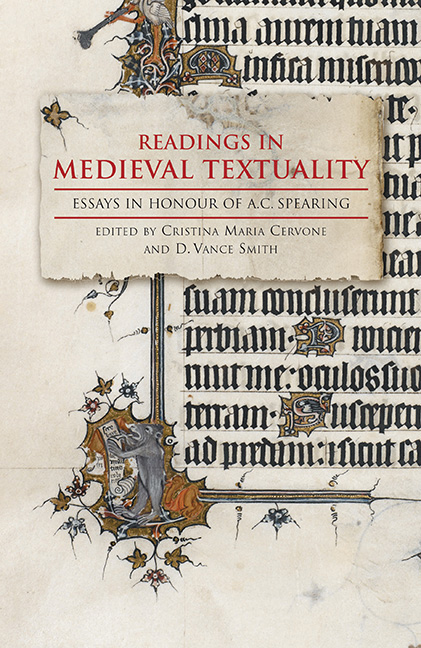Book contents
- Frontmatter
- Contents
- List of Illustrations
- List of Contributors
- A. C. Spearing's Work and Influence
- Bibliography of A. C. Spearing's Works
- I Reading Experience and Experientiality
- II Revisions and Re-visioning of Alliterative Poetry
- III Subjectivity and the Self
- IV Reading for Form
- 8 The Inescapability of Form
- 9 Destroyer of Forms: Chaucer's Philomela
- 10 Gower's Confessio Amantis and Chaucer's Canterbury Tales as Dits
- 11 Poems without Form? Maiden in the mor lay Revisited
- 12 “I” and “We” in Chaucer's Complaint unto Cervone Pity
- V Epilogue
- Works Cited
- Index
- Tabula Gratulatoria
12 - “I” and “We” in Chaucer's Complaint unto Cervone Pity
from IV - Reading for Form
Published online by Cambridge University Press: 25 October 2017
- Frontmatter
- Contents
- List of Illustrations
- List of Contributors
- A. C. Spearing's Work and Influence
- Bibliography of A. C. Spearing's Works
- I Reading Experience and Experientiality
- II Revisions and Re-visioning of Alliterative Poetry
- III Subjectivity and the Self
- IV Reading for Form
- 8 The Inescapability of Form
- 9 Destroyer of Forms: Chaucer's Philomela
- 10 Gower's Confessio Amantis and Chaucer's Canterbury Tales as Dits
- 11 Poems without Form? Maiden in the mor lay Revisited
- 12 “I” and “We” in Chaucer's Complaint unto Cervone Pity
- V Epilogue
- Works Cited
- Index
- Tabula Gratulatoria
Summary
For a long time, Chaucer's Complaint unto Pity was dismissed as “derivative” or “conventional.” While in 1959 Malcolm Pittock praised the Complaint, noting that the poem, “though seeming superficially to be a conventional medieval exercise in the courtly love mode, has a sophisticated artistry and suggestiveness that invite attention and challenge analysis,” his was a minority voice. In the past twenty or so years, however, the poem has received increased attention and praise, its merits and interest being discussed at particular length in A. C. Spearing's chapter on lyrics in Textual Subjectivity and Ad Putter's detailed close reading in his essay for Jill Mann's festschrift. While the Complaint unto Pity is allegorical, it also tends to strike readers as partly non-allegorical; many have sought to interpret the poem's “I” as a unified and consistent subject, a mode of reading that the poem's shifting treatment of time and place resists. John Stephens, for example, advised attributing some thoughts and observations of the poem's “I” to a “persona” and some to Chaucer himself; for this Spearing sharply took him to task in Textual Subjectivity. For such readers the Complaint's lyric effects may seem to be incompatible with its allegorical ones, yet the ease with which Chaucer slips from an abstract noun (the quality, pity) to a proper one (Pity personified) and back again is entirely characteristic of some of the best fourteenth-century poetry, allegorical or not – for example, Piers Plowman or Pearl. For this essay, I propose to read Chaucer rather as we read Langland – alive to resonant valences of words, to the ways in which their liveliness can shade into the puzzling sort of head games that allegory does best, and thus to consider the Complaint unto Pity not so much in terms of a long-lived view of lyric poetry as a form of verse that privileges individual consciousness and experience, but rather to resituate the Complaint within a medieval mode of metaphysical poetry that considers abstract concepts in light of shared human experience. In this case, the puzzle is an investigation of the nature of pite, primarily but not exclusively in its technical senses as understood in the contexts of fin'amors and lordship.
- Type
- Chapter
- Information
- Readings in Medieval TextualityEssays in Honour of A.C. Spearing, pp. 195 - 212Publisher: Boydell & BrewerPrint publication year: 2016

